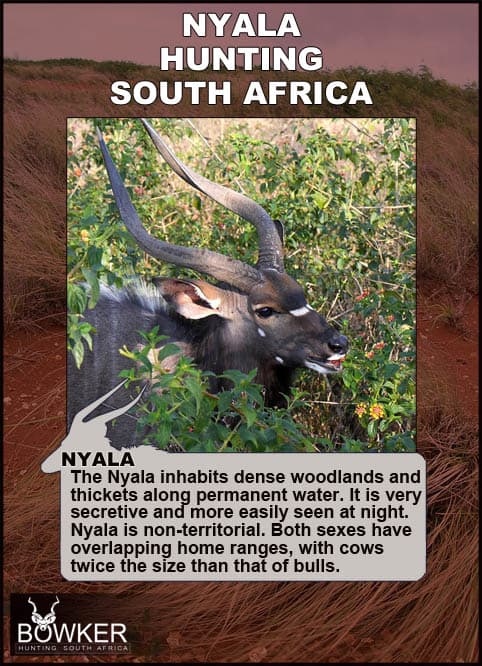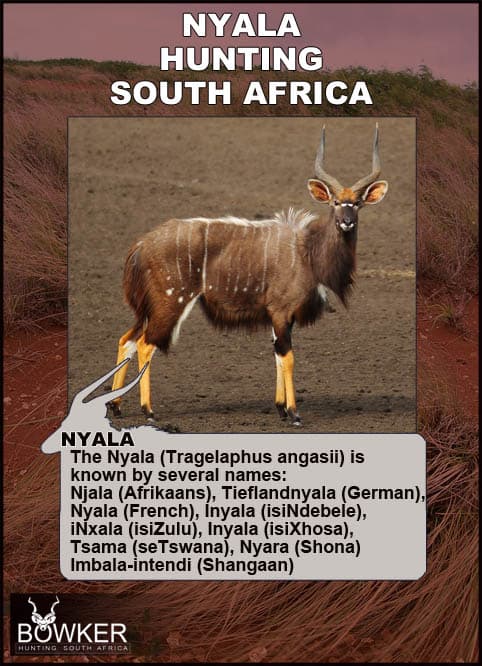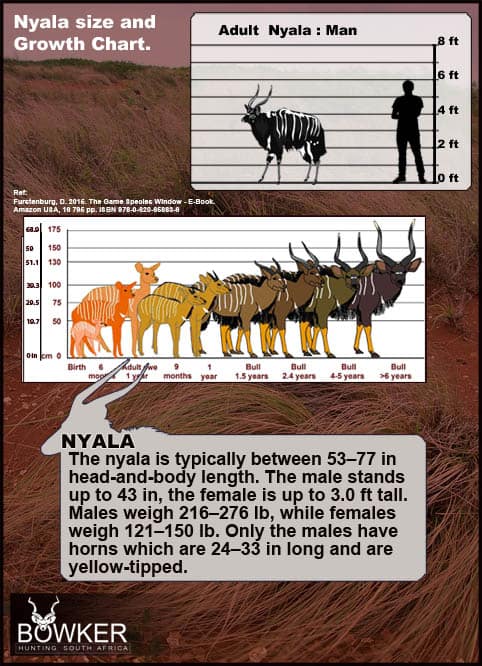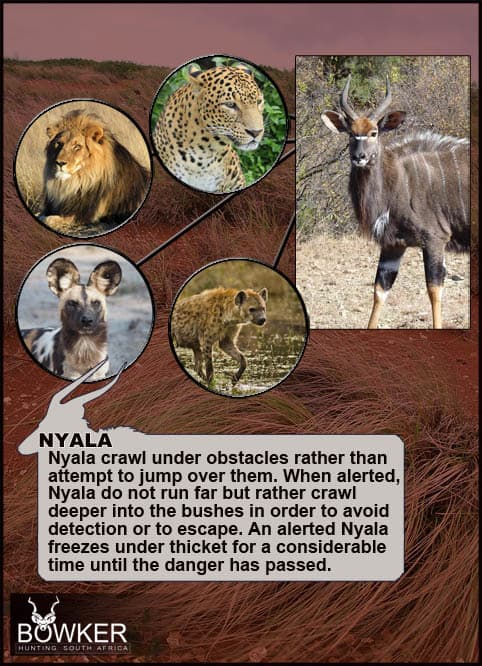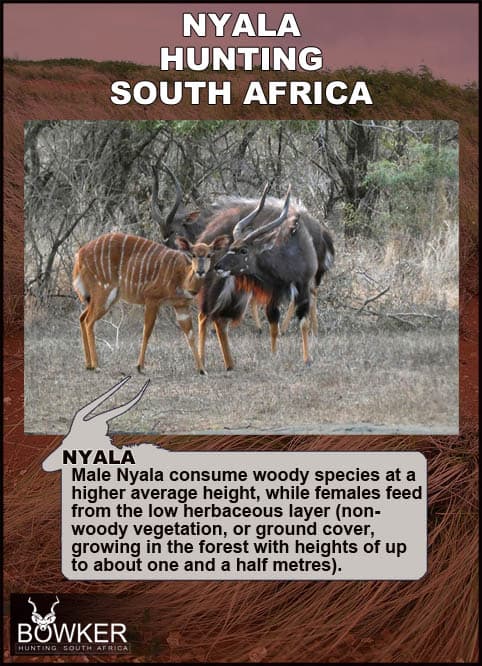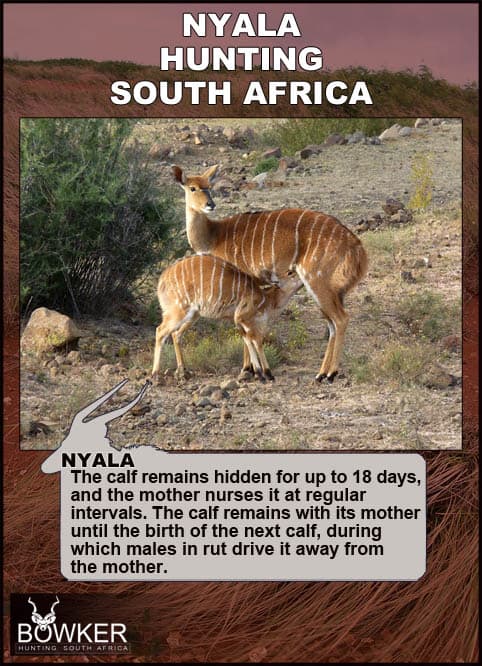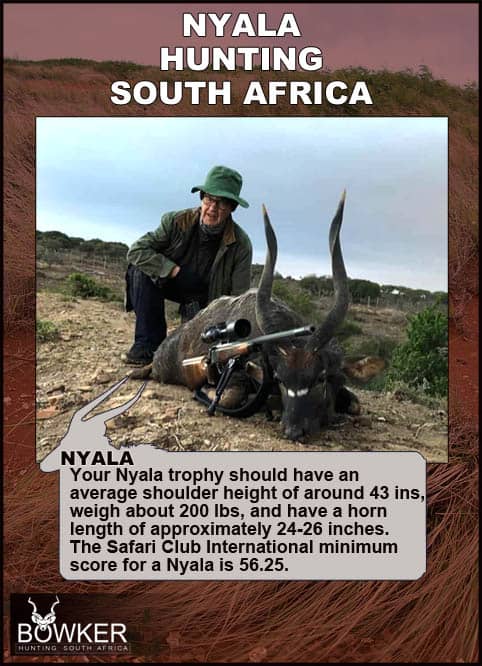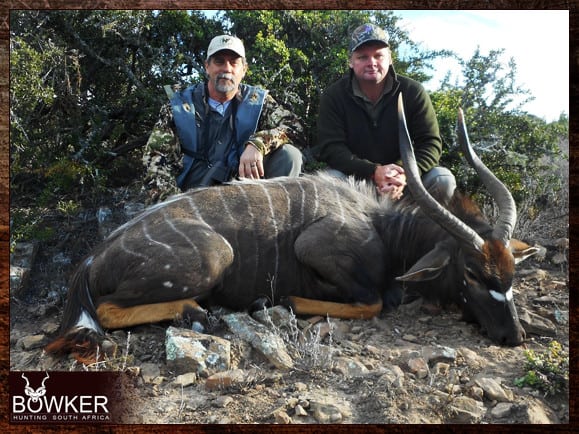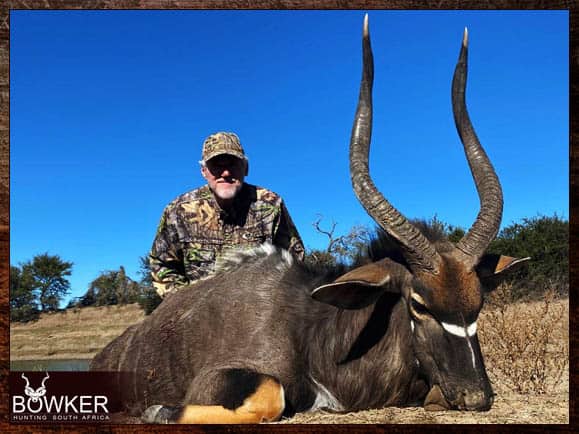
Summary
Nyala hunting is a must for any aspiring hunter going to Africa.
The Nyala is a very sought-after trophy and one of the most beautiful African antelopes to hunt.
No seasonal restrictions exist for hunting Nyala in the Eastern Cape areas of South Africa.
We offer year-round trophy Nyala hunting in South Africa and many other species.
Join us for unforgettable safaris and wildlife trips at our ranch and new lodge, Hopewell.
We are excited to meet you at the Port Elizabeth airport.
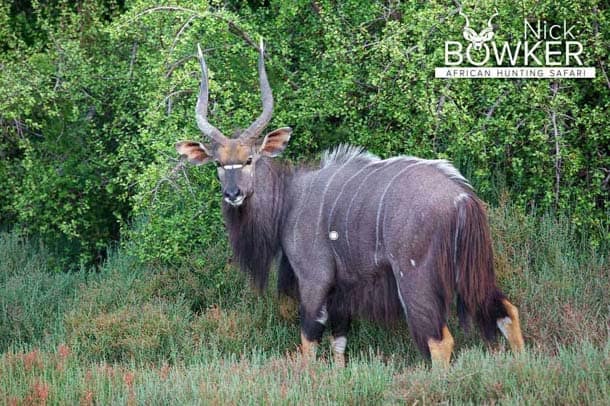
Table of Contents
Nyala Trophy Fees in South Africa – 2025
The average price of a Nyala is $2000. African hunting safari packages often include a Nyala Trophy.
Our Nyala price for 2025 is $2000.
All-Inclusive $7500 Starter Plains Game Package for seven trophies and eight days hunting. (Inclusive of a Nyala Trophy)
- Kudu
- Nyala
- Springbok
- Blesbok
- Impala
- Warthog
- Mountain Reedbuck
You can add any plains game, such as Black Wildebeest, off the price list to your package. Observer rates are $150 per day.
Included in the Nyala trophy hunting package is a licensed hunting guide. As well as a hunting license and all permits.
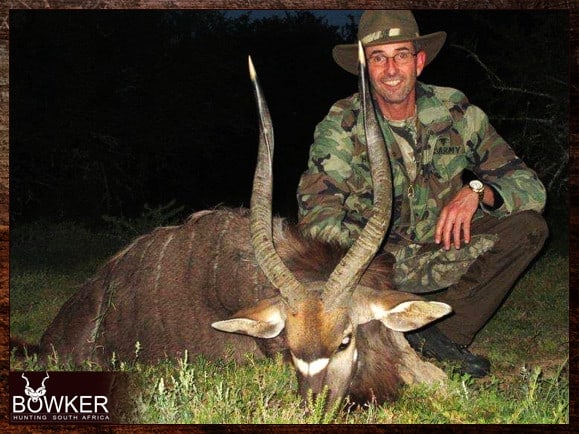
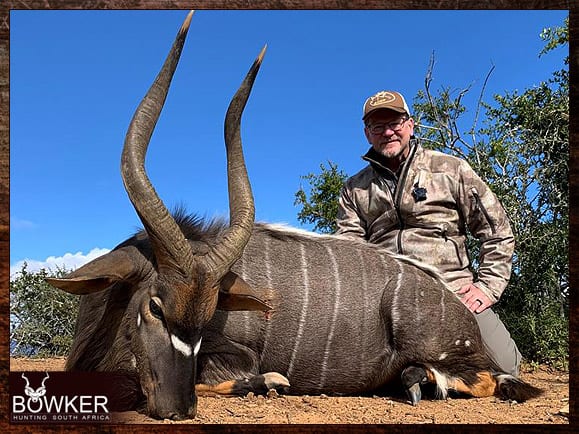
Nyala Hunting in South Africa

Shot placement must be in the bottom third of the animal directly above the front shoulder. This will ensure a heart or lung shot. Avoid head and neck shots, which are high-risk.
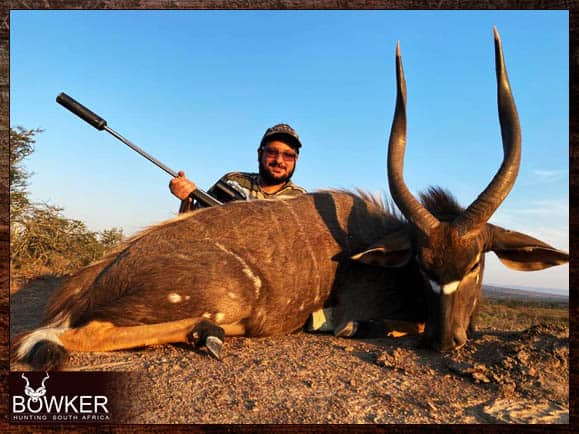
Your Nyala trophy should have an average shoulder height of about 43 inches, weigh about 200 pounds, and have a Horn Length of approximately 24 – 26 inches.
The Safari Club International minimum score for a Nyala is 56.25.
The trophy is measured by adding each horn’s length and the horn bases’ circumference.
Nyala and the sable are considered by many to be the most beautiful African game antelope.
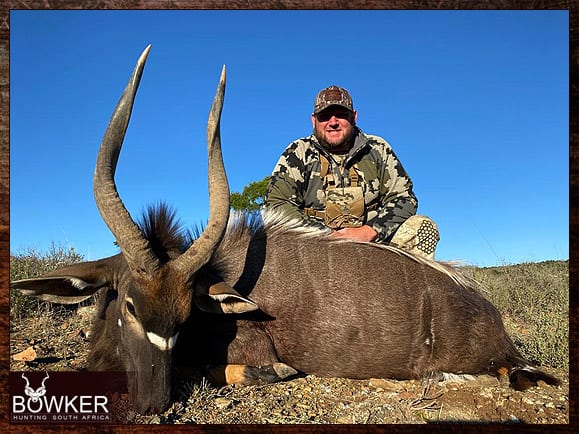
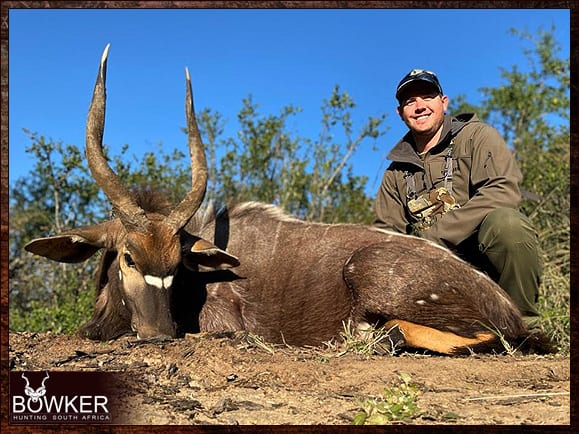
A top sought-after trophy. Nyala will be hunted in a thick bush. As a result, many Nyala bulls are often shot in the last 20 minutes of light.
A Nyala bull stepping out from the bush into an opening and giving you your shot after hours of glassing will be a lasting memory for any hunter.
Nyala often has little or no blood trail when wounded because of their thick coat, which absorbs the blood.
Therefore, an excellent first shot is vital.
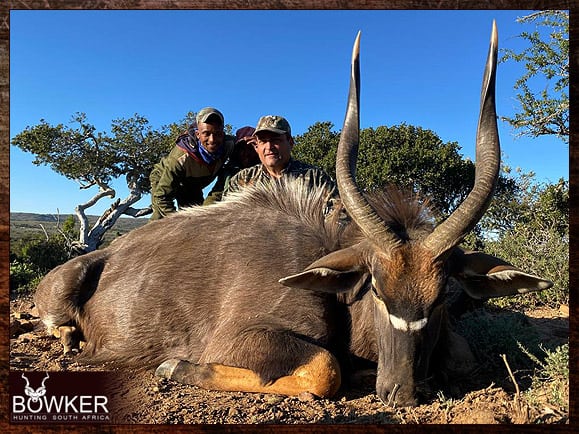
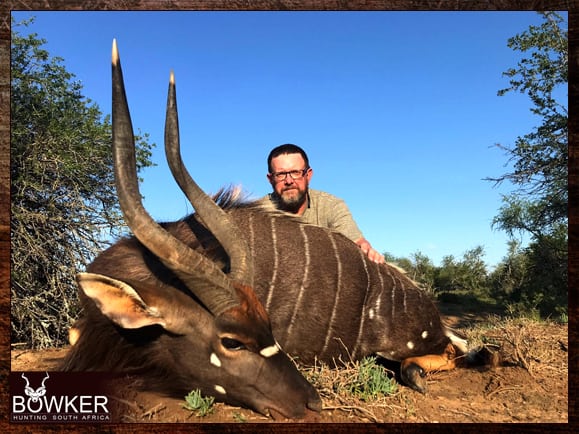
Trophy Judgement and Rifle Caliber
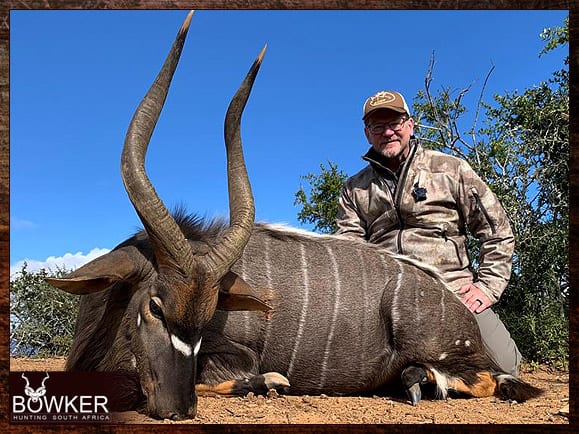
Hunting Nyala safari-style calls for quality expanding bullets. The various 30 calibers would be an excellent choice to anchor your Nyala.
Also, we would once again recommend the flat shooting 7mm or 300 magnums as the best calibers.
For those hunters who wish to avoid going through the red tape of bringing a rifle into South Africa, Nick Bowker 300 Magnums fitted with suppressors.
Mounted on the rifles are high-end Swarovski tactical scopes. We have hand-loaded Hornady ELD-X 200-grain ammunition available.
The rifle, including ammunition, is available as part of all hunting packages free of charge.
A Nyala trophy hunt is spotted in the thick brush from an elevated vantage point and then stalked in the early mornings and late evenings.
Hunt Nyala on sunny days. It can be challenging to find overcast days.

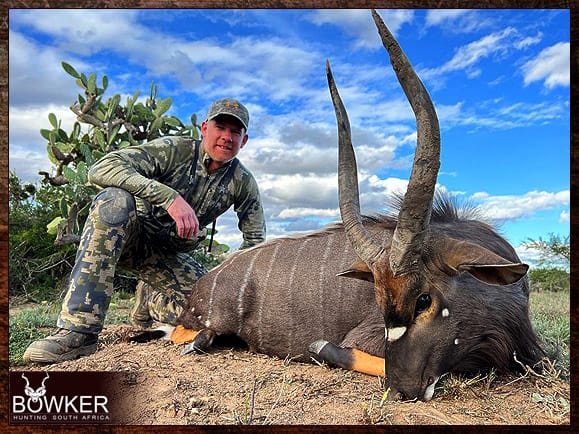
Alternatively, hunters use ambush techniques at watering holes or as they move back to cover from feeding. Nyala drinks water daily.
As with most African trophies, shot placement should always be in the bottom third of the shoulder. An excellent first Nyala shot is essential.
While most Nyala hunts occur behind high fences in the Eastern Cape, Nick Bowker has access to several free-range herds in the Bedford area.
The Africa Nyala forms part of the Spiral Horned game family and is the most beautiful, consisting of Kudu, Nyala, Bushbuck, and Eland.
Like most spiral horns, a Nyala must have solid bases that go outwards. The tips must be pointing straight up or flaring outwards. It is a must for those hunters interested in collecting the spiral horn family.
The male has a wide chevron mark between the eyes, a white-tipped mane, and iconic orange “socks.” Resulting in a magnificent antelope.
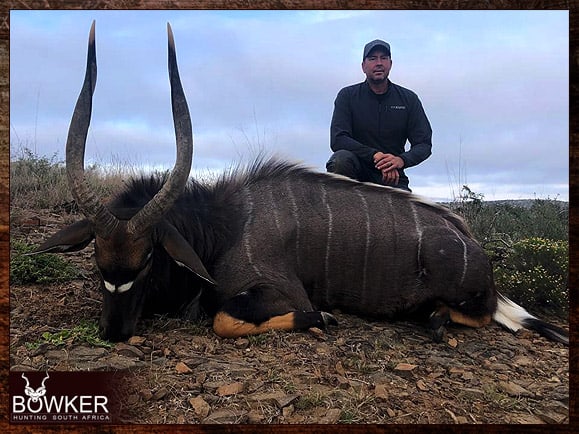
Difference Between a Male and Female
Male Nyala have horns and are much larger than females. They have a facial chevron, which females do not have. A Nyala male is darker in color with a grey coat and far fewer white stripes, which are also less prominent.


Interesting Facts for Hunts
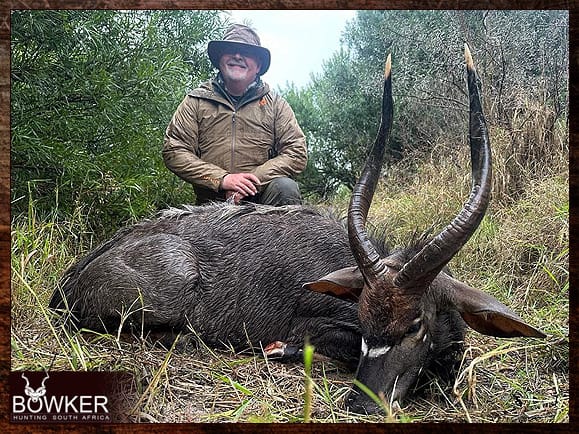
- Nyala is the most sexually dimorphic antelope in the world. And not only does the male look wholly different, but he weighs twice as much as the female.
- The Nyala is a true grazer and browser. Their diet has helped them become widespread across Africa.
- Nyala also strips the bark off trees.
- Nyala is not very fast or strong. Inhabiting deep in woodland or forest, their defense against predators is their camouflage.
- Nyala has a special bond with monkeys and baboons. The antelope eat all the fruit that their primate friends drop.
- Also, they can react to any alarm call made by the primates and other antelope.
- Nyala has exceptional hearing and smell and will give off a striking alarm call; consisting of a sharp, high-pitched sound is almost like a dog bark.
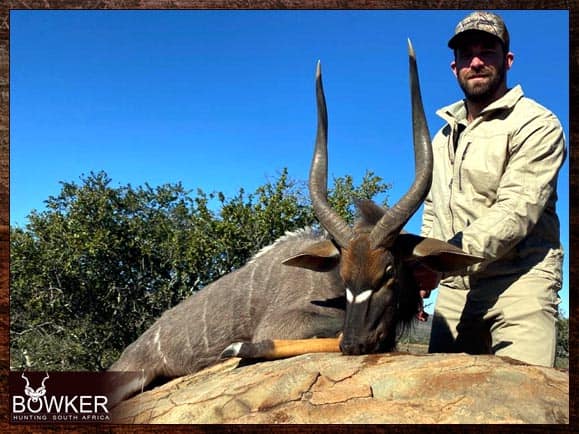
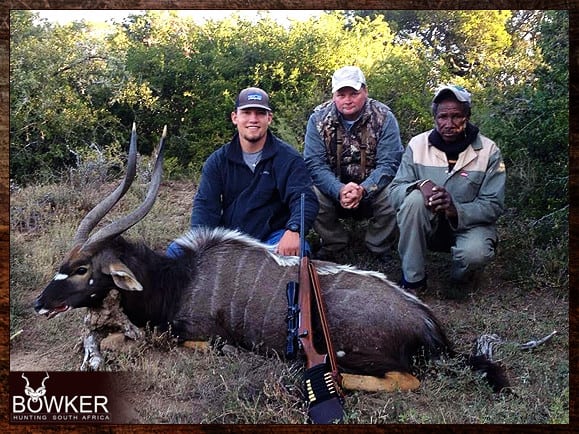
- Most of Africa’s mammals have a clearly defined social structure, such as impala.
- Nyala is the nomad of the antelope world. They live in loose groups of 4 to 8 animals.
- All these groups are temporary. Nyala join other Nyala leave.
- Battles between bulls are dramatic and brutal. Bulls keep fighting until one backs down. Upon defeat, a bull will turn away and wag his tail in submission.
- The victorious bull uses bizarre stuttering movements and will slowly dance with a group of females, raising its head to show off its white underfur.
- The evolutionary line of the Nyala has remained separate for five million years, making them one of the oldest game antelopes.
- Nyala should be taken by any hunter on a trip to Africa.
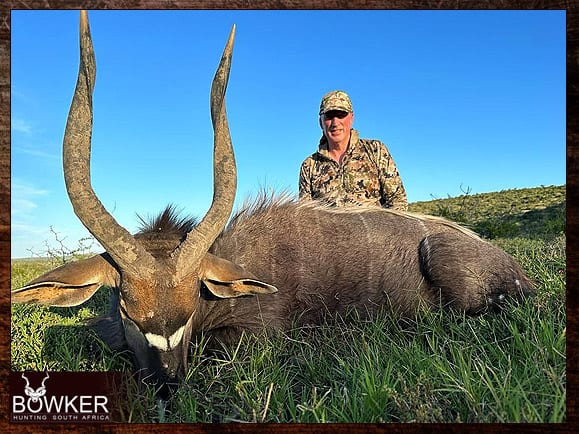
About the Nyala for Hunters
Description of Your Game Quarry
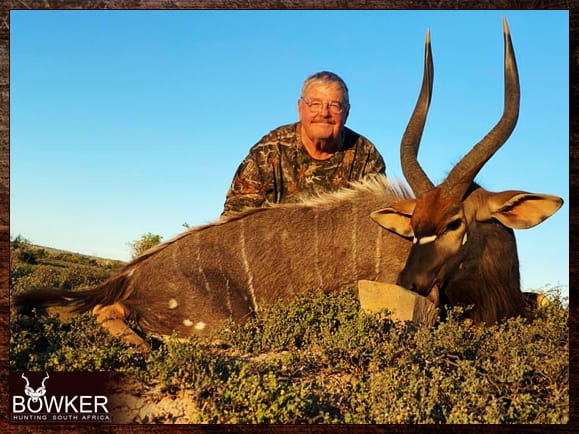
The Nyala is mainly active in the early morning and late evening at all times of the year. A shy animal, preferring thick cover and will only be seen in open spaces in the early morning or just before sundown.
The Nyala shows no signs of territoriality, and individuals’ areas can overlap.
They are very cautious creatures. Old males tend to live alone, but single-sex or family groups of up to 12 individuals can be found together.
These inhabit thickets within dense and dry savanna woodlands.
The Nyala is a spiral-horned antelope and is between a bushbuck and a kudu in size.
The male stands up to 47 inches; the female is up to 35 inches tall. Males weigh 180 – 220 pounds, while females weigh 120 – 150 pounds. The life expectancy of the beautiful Nyala is about 19 years.
The coat of females and juveniles is rufous-brown. However, it grows a dark brown or slate gray in adult males, often with a bluish tinge.
Young males and females have at least ten or more white vertical stripes on their sides. Other markings are visible on the face, throat, flanks, and thighs.
Stripes are significantly reduced or absent in older males. But both sexes have a dorsal crest of hair running right from the back of the head to the end of the tail.
Males have an imposing long “beard” along the midline of their chest and belly.
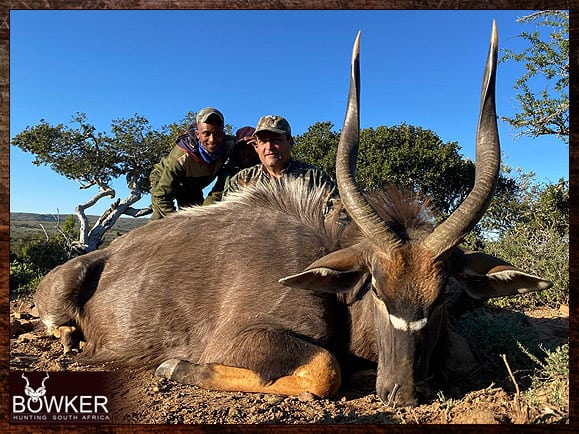
General Information for hunting Nyala
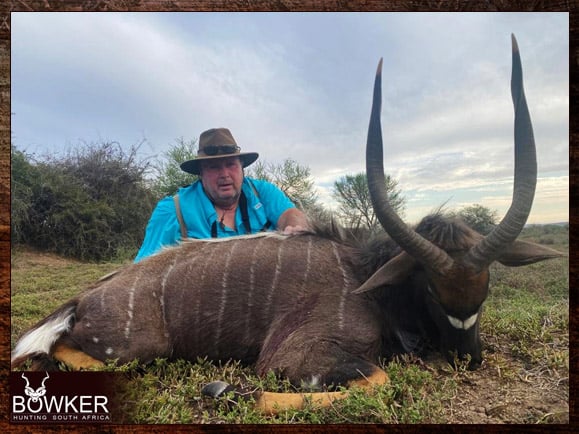
Males begin to lose their stripes as they start to mature. This is because juvenile males disguise themselves as females avoiding any jealous behavior from adult males.
Nyala antelopes have tiny hooves for their body size. As they walk, the hind feet step into the position where the front feet have just been known as registering and reducing the amount of noise made with each step.
The bases of the back of the ears are white, as is the underside of the fluffy tail, which is raised when the animal takes fright.
The fluffy tail acts as a ‘follow me’ symbol to the young.
The whitetail’s flash also provides a stark target to a predator, but as soon as the Nyala stops, the tail is dropped, and the predator’s focus is lost.
The disruptive camouflage markings then come into play, further concealing the curious Nyala from the predator’s view so long as it remains still.
The same applies to the Nyala pursuit, where much patience is required.
The thicket habitat of the Nyala provides an ideal cover for the calves when they are born.
In the first two to three weeks of their lives, they remain hidden to allow them to build up their strength before moving around with the adults.
The mother visits her calf for feeding and grooming. If it becomes threatened, the calf instinctively flattens itself onto the ground. Due to its lack of scent at such a young age, it can easily avoid predators’ attention this way.
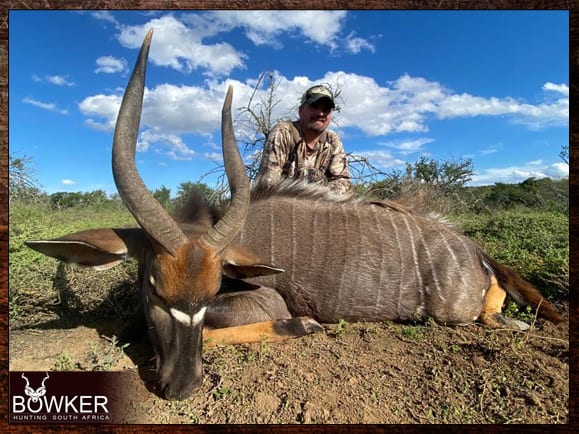
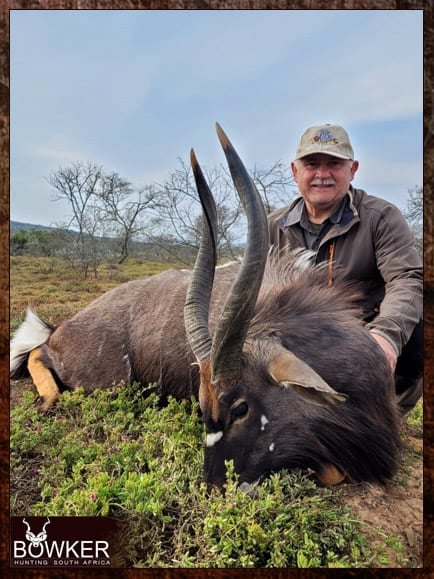
Frequently Asked Questions
How much does it cost to hunt a Nyala?

Trophy fee as a standalone Nyala hunt are between $2,000 – $2,500. Daily rates vary between $250 and $500 per day.
Included in the Nyala trophy fee is a licensed guide. As well as a hunting license and all permits.
A Nyala trophy is often included in a plains game package. Package prices vary from $ 3,000 to $10,000, depending on location and trophies. Packages include 5 – 7 trophy animals, accommodation, meals, and daily rates.
How to hunt a Nyala?
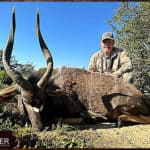
Nyala hunting is in the early mornings and late evenings and spotted from an elevated vantage point in the thick brush and then stalked. Alternatively, hunters use ambush techniques at watering holes or as they move back to cover from feeding. Nyala is tough to find on overcast days.
Where do you shoot a Nyala?
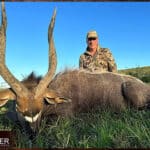
Shot placement must be in the bottom third of the animal directly above the front shoulder. This will ensure a heart or lung shot. Avoid head and neck shots, which are high-risk.
What is a trophy, Nyala?
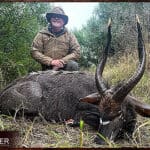
Nyala trophies have a Horn Length of approximately 24 – 26 inches. The minimum qualification score under Safari Club International for a Nyala is 56. Add the length of each horn and the circumference of the bases to get your SCI score.
How do you judge a Nyala trophy?

The tips must be pointing straight up or flaring outwards. Like most spiral horn trophies, a nyala must have solid bases that go outwards.
Seasonal Restrictions
When can you hunt Nyala in South Africa?
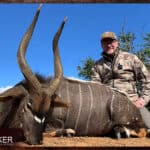
There are no seasonal restrictions on nyala in the Eastern Cape of South Africa.
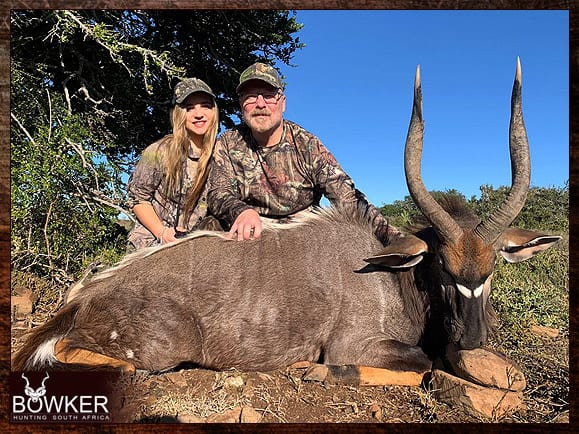
What Caliber is Recommended for Nyala Hunts?
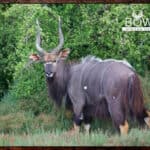
We recommend the flat shooting 300 Winchester or 7mm magnums with high-quality tactical scopes and a suppressor.
In Pictures

